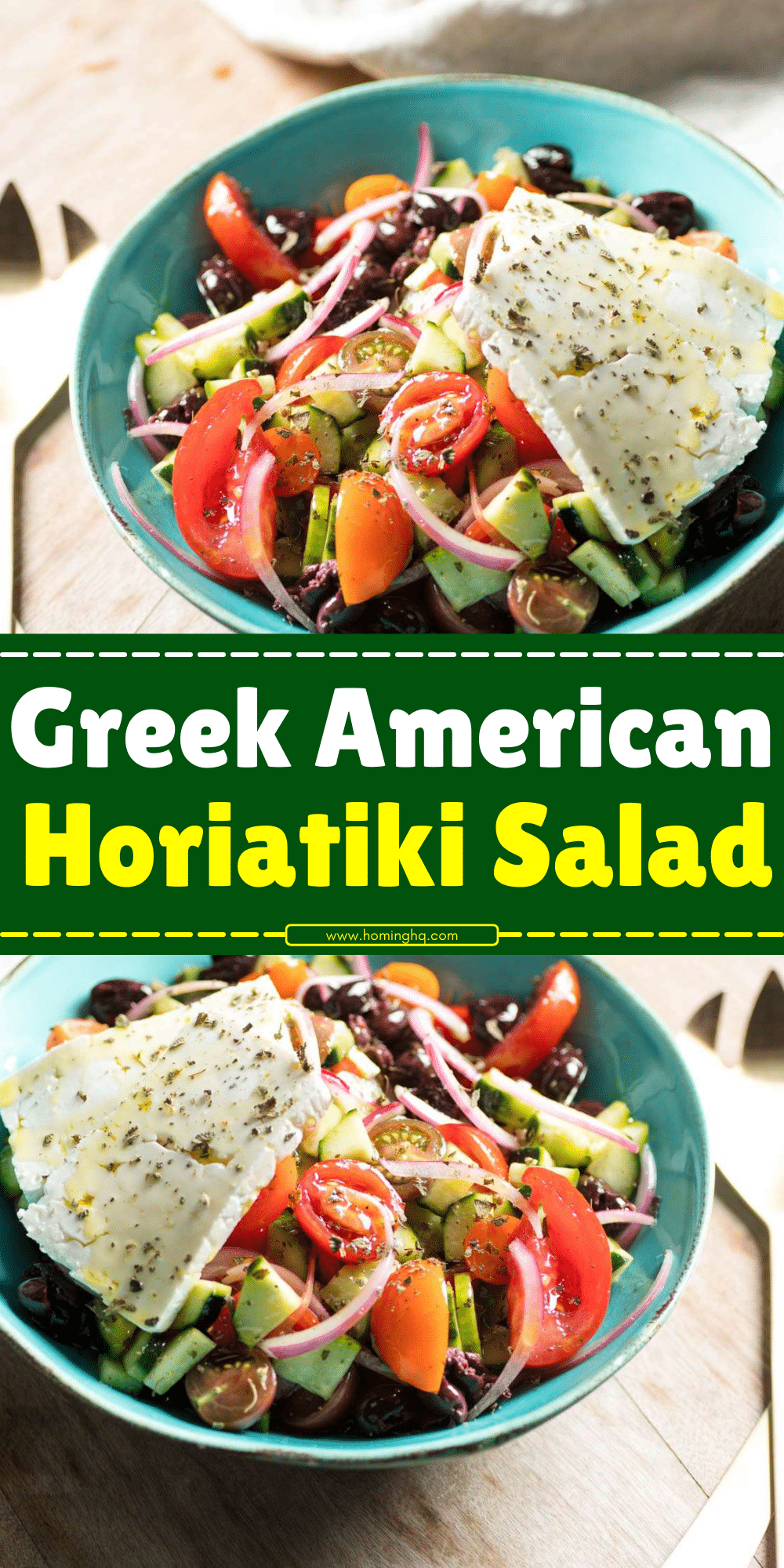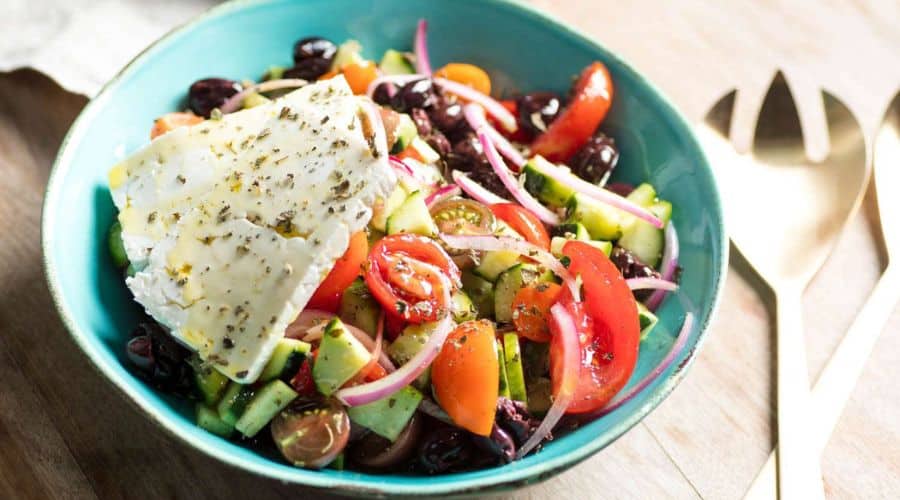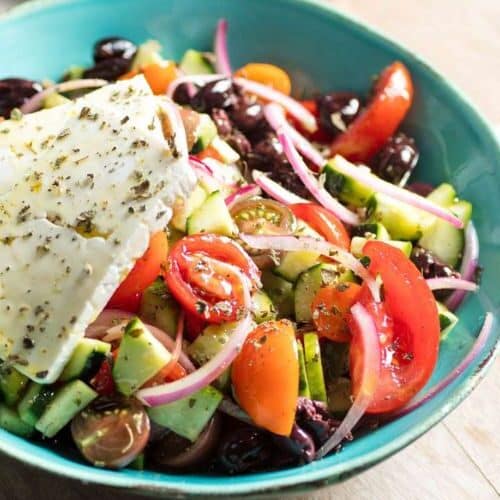The Greek-American Horiatiki Salad, also known as the Greek Village Salad, is a refreshing and vibrant dish that combines fresh vegetables, briny olives, and creamy feta cheese, all drizzled with a tangy olive oil dressing.
This salad is a fusion of the classic Greek Horiatiki Salad with a slight American twist, making it not only delicious but versatile enough for various tastes.
Whether you’re enjoying it as a light meal, a side dish, or a picnic treat, this salad embodies the essence of the Mediterranean diet—simple, fresh, and full of flavor.
In this blog, we’ll guide you through the history, ingredients, and preparation to create the perfect Greek-American Horiatiki Salad in your kitchen.

What is Horiatiki Salad?
Horiatiki Salad is a traditional Greek dish that originated in the villages of Greece.
The name “Horiatiki” literally translates to “village salad,” as it was typically made with ingredients that were easy to find in rural areas.
A classic version consists of fresh tomatoes, cucumbers, red onions, Kalamata olives, and a large chunk of feta cheese, all dressed with olive oil, red wine vinegar, and dried oregano.
The salad is a symbol of Greek culinary simplicity, focusing on high-quality, fresh ingredients that shine through in every bite.
While the traditional recipe is a staple in Greek homes and tavernas, the American version often includes slight modifications, such as the addition of grilled proteins or more modern twists to suit various tastes and dietary preferences.
Key Ingredients in Greek-American Horiatiki Salad
The Greek-American Horiatiki Salad is composed of fresh, healthy ingredients that deliver a burst of flavors. Here are the key components that make this salad both delicious and nutritious:
Tomatoes
Ripe, juicy tomatoes are the star of the show. Opt for heirloom or vine-ripened varieties for the best taste. They provide a sweet and tangy base that balances well with the saltiness of the feta and olives.
Cucumbers
Fresh cucumbers add a crisp and refreshing crunch to the salad. Whether you peel them or not is entirely up to your preference. The cucumbers’ mild flavor pairs beautifully with the more intense ingredients.
Red Onions
Thinly sliced red onions lend a touch of sharpness and color to the salad. Their slightly spicy bite contrasts nicely with the sweetness of the tomatoes and the richness of the feta.
Bell Peppers
Bell peppers (often green, but red, yellow, or orange varieties can also be used) provide both texture and color, enhancing the overall visual appeal and flavor of the salad.
Kalamata Olives
Kalamata olives are a must in this dish. Their dark purple hue and bold, briny flavor add an authentic Mediterranean touch that balances the sweetness of the vegetables.
Feta Cheese
Feta is the quintessential Greek cheese for this salad. Traditionally, it’s served in a large block, rather than crumbled, and it’s crucial for achieving the characteristic tanginess. Make sure to use high-quality feta for the best flavor.
Olive Oil
Extra virgin olive oil is the best choice for dressing the salad. It brings richness and depth of flavor, tying all the ingredients together.
Herbs and Seasonings
Oregano is the traditional herb used in a Horiatiki Salad, lending a fragrant, earthy flavor that complements the vegetables. A pinch of salt and freshly cracked black pepper enhances the flavors of the salad.
Red Wine Vinegar
Red wine vinegar gives the salad a mild tang that perfectly balances the richness of the olive oil and the saltiness of the feta cheese.
Optional Add-Ins for a Greek-American Twist
While the traditional Greek Horiatiki Salad is already packed with flavor, there are several optional add-ins that can give it a unique Greek-American twist. These additions can make the salad heartier or introduce new flavors to suit various preferences:
Grilled Chicken or Lamb
For a more substantial meal, grilled chicken or lamb can be added. The smoky, tender meat complements the crisp vegetables and creamy feta, turning the salad into a more filling option for lunch or dinner.
Avocado
Adding avocado is a modern American touch. The creamy, buttery texture of avocado works harmoniously with the other ingredients and offers an extra layer of richness.
Capers
Capers add a burst of briny flavor and an extra touch of Mediterranean authenticity. They can be scattered throughout the salad for an added tangy bite.
Lemon Zest or Juice
For a fresh, zesty lift, lemon zest or a squeeze of lemon juice can be incorporated. This adds a citrusy brightness that elevates the salad’s flavors, making it even more refreshing.
Step-by-Step Instructions for Preparing Greek-American Horiatiki Salad

Creating the perfect Greek-American Horiatiki Salad is simple and quick. Follow these easy steps to assemble your vibrant dish.
Step 1: Prep the Vegetables
Begin by washing and prepping all your vegetables. Slice the tomatoes into wedges or large chunks. If you prefer a crisper texture, keep the skin on the cucumbers; otherwise, peel them before slicing them into half-moons. Thinly slice the red onion and bell peppers, cutting the peppers into strips or bite-sized pieces. Drain and rinse the Kalamata olives.
Step 2: Assemble the Salad
In a large bowl, combine the sliced tomatoes, cucumbers, red onions, bell peppers, and Kalamata olives. If you’re using avocado, you can dice it at this stage and gently add it to the mix.
Step 3: Add the Feta Cheese
Break or slice the feta cheese into large blocks or chunks. Add it on top of the vegetables in the bowl. You can crumble it slightly if you prefer a more distributed texture or leave it in chunks for a more traditional presentation.
Step 4: Make the Dressing
In a small bowl or jar, whisk together extra virgin olive oil, red wine vinegar, dried oregano, salt, and freshly ground black pepper. You can adjust the seasoning to your liking, but the dressing should have a balanced tang from the vinegar and richness from the olive oil.
Step 5: Dress the Salad
Pour the dressing over the salad ingredients, then gently toss everything together. Be careful not to crush the feta too much if you left it in large pieces. If you added grilled meat, you can now place it on top for added flavor.
Step 6: Serve and Enjoy
Once everything is nicely coated in the dressing, the Greek-American Horiatiki Salad is ready to serve. It’s best enjoyed immediately for the freshest taste.
How to Serve Greek-American Horiatiki Salad
Greek-American Horiatiki Salad is incredibly versatile and can be served in various ways to suit your meal:
- As a Side Dish: Serve it alongside grilled meats such as chicken, lamb, or fish. It pairs especially well with Mediterranean dishes like grilled souvlaki or a hearty tzatziki dip.
- As a Light Main Course: For a lighter meal, enjoy it on its own or with a slice of freshly baked pita bread.
- With Grilled Proteins: If you’re looking for a more filling meal, add grilled chicken, lamb, or even steak to the salad. The smoky flavors of the protein complement the freshness of the salad beautifully.
- Pair with Wine: For an extra touch of elegance, pair your Horiatiki Salad with a glass of crisp, dry white wine like a Greek Assyrtiko or a Sauvignon Blanc.
Conclusion
The Greek-American Horiatiki Salad is an easy-to-make yet flavorful dish that brings the best of Greek cuisine to the table with a modern American twist. Packed with fresh vegetables, rich feta cheese, Kalamata olives, and a zesty dressing, this salad is perfect for any occasion. Whether you serve it as a side dish, a main course with grilled protein, or simply enjoy it on its own, it offers a healthy, vibrant meal that’s sure to satisfy. The versatility of this salad means you can easily personalize it to your tastes, making it a great choice for family gatherings, picnics, or weeknight dinners.
Enjoy this fresh, Mediterranean-inspired dish and embrace the flavors of Greece with a simple, homemade twist!
Frequently Asked Questions
1. Can I use a different type of cheese if I don’t have feta?
While feta is traditional in a Horiatiki Salad, you can use other cheeses like goat cheese or even mozzarella if you prefer a milder taste. However, the tangy flavor of feta is an integral part of the salad’s authentic taste.
2. Can I prepare this salad in advance?
Horiatiki Salad is best when served fresh, as the vegetables can lose their crispness over time. However, you can prep the ingredients (chop vegetables, prepare dressing) ahead of time and assemble the salad just before serving.
3. Is the Greek-American Horiatiki Salad gluten-free?
Yes, the Greek-American Horiatiki Salad is naturally gluten-free, making it a great option for those with gluten sensitivities or celiac disease. Just ensure your dressing ingredients don’t contain any hidden gluten.
4. How long will leftovers keep in the fridge?
If you have leftovers, they can be stored in an airtight container in the fridge for up to 2 days. The vegetables may become a little softer, but the salad will still be tasty. Avoid storing it with the dressing to keep it fresher for longer.
5. Can I add more vegetables to the salad?
Absolutely! Feel free to add other vegetables like radishes, zucchini, or even artichoke hearts to the salad. The key is using fresh, in-season ingredients to maintain the salad’s vibrant flavor.

Greek-American Horiatiki Salad
Equipment
- 1 large mixing bowl
- 1 small bowl for dressing
- 1 whisk or fork (for mixing dressing)
- 1 Knife (for chopping vegetables)
- 1 Cutting Board
- 1 spoon or tongs (for tossing salad)
Ingredients
- 2 medium tomatoes sliced
- 1 cucumber sliced
- 1 red onion thinly sliced
- 1 bell pepper green, red, or yellow, sliced
- 1/2 cup Kalamata olives pitted
- 8 oz feta cheese preferably in block form
- 1/4 cup extra virgin olive oil
- 2 tbsp red wine vinegar
- 1 tsp dried oregano
- Salt and pepper to taste
Optional add-ins:
- 1 avocado diced
- Grilled chicken or lamb optional (for a more filling version)
- 1 tbsp lemon juice or zest for extra brightness
Instructions
- Prep the Vegetables: Wash and slice the tomatoes, cucumbers, red onion, and bell pepper into bite-sized pieces. Slice or dice the avocado if using, and drain the Kalamata olives.
- Assemble the Salad: In a large mixing bowl, combine all the vegetables and olives. Add the feta cheese in large chunks or crumble it on top.
- Make the Dressing: In a small bowl, whisk together olive oil, red wine vinegar, oregano, salt, and pepper. Taste and adjust seasoning if needed.
- Toss the Salad: Drizzle the dressing over the salad and toss gently to combine, being careful not to break the feta cheese too much.
- Serve and Enjoy: Serve immediately as a side dish, or add grilled chicken or lamb for a main course. Optionally, garnish with lemon zest or juice for extra zest.
Notes
- Customization: Feel free to customize the vegetables based on what’s in season or your personal preferences. Zucchini, radishes, or even olives can be added to make the salad your own.
- Storage: This salad is best served fresh, but leftovers can be stored in an airtight container in the fridge for up to 2 days.
- Vegan Option: To make this salad vegan, omit the feta cheese or substitute it with a plant-based feta.

